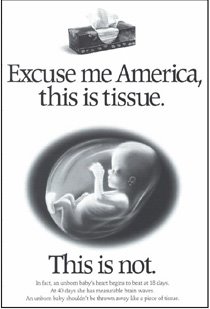The Dollars and Cents of One Human Life
 One life taken by abortion. What’s the cost to Canadian society?
One life taken by abortion. What’s the cost to Canadian society? I get tired of hearing the same old argument that the thousands and millions of children aborted in Canada would simply have been a drain on our resources anyway. As if to say, these children are now better off, having been saved from depleting Canadian resources and most likely a life of great poverty.
How shallow and barbaric our thinking has become. What a weak argument to appease our seared consciences and justify the child killing that goes on in Canada at the rate of 12 unborn children per hour.
Perhaps you have heard of Population Research Institute and its president, Stephen J. Mosher. Founded in 1989, Population Research Institute is a non-profit research and educational organization dedicated to objectively presenting the truth about population-related issues.
In 2005, Mosher wrote a powerful piece dispelling some of the myths about the actual "cost" of human life. His facts and figures centre around the American setting but our Canadian situation would be little different. From his "must read" article It’s the Birthrate Stupid this is the shocking truth about the value of our [unwanted] children:
… what is the economic value of an American baby at conception? The Department of Agriculture estimates the cost of raising a child born in 2005 at around $200,000 over twenty years, a substantial (and probably exaggerated) sum of money. But the future earnings of the child from 2025 to 2070—assuming that wages continue to rise at their current rate—will be well over ten times this amount, probably in the neighborhood of between $4 and $5 million. Discounting these future costs and benefits to the present produces a figure of around $600,000. How many people realize that every abortion is the death of a small fortune—and another nail in the coffin of Social Security?
And another excellent eye opener from about the same time period by Mark Steyn "Strange Death of the Liberal West,"
Most 20-year projections - on global warming, fuel resources, etc - are almost laughably speculative. They fail to take into account the most important factor of all - human inventiveness: "We can't feed the world!" they shriek. But we develop more efficient farming methods with nary a thought. "The oil will run out by the year 2000!" But we develop new extraction methods and find we've got enough oil for as long as we'll need it.
But human inventiveness depends on humans - and that's the one thing we really are running out of. When it comes to forecasting the future, the birth rate is the nearest thing to hard numbers. If only a million babies are born in 2005, it's hard to have two million adults enter the workforce in 2025 (or 2033, or 2041, or whenever they get around to finishing their Anger Management, Systemic Racism and Gay Studies degrees). If that's not a political issue, what is? To cite only the most obviously affected corner of the realm, what's the long-term future of the Scottish National Party if there are no Scottish nationals?
Canada's current situation was recently summed up in this article.
How often is too often to discuss the devastation of abortion?
I don’t know. But we’re not anywhere’s close.


























0 Comments:
Post a Comment
<< Home